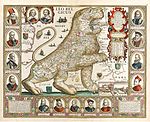
Back Suidelike Nederlande Afrikaans الأراضي المنخفضة الجنوبية Arabic Паўднёвыя Нідэрланды Byelorussian Izelvroioù ar Su Breton Països Baixos del sud Catalan Sydlige Nederlande Danish Südliche Niederlande German Νότιες Κάτω Χώρες Greek Países Bajos meridionales Spanish Lõuna-Madalmaad Estonian
| History of Belgium |
|---|
 |
|
Timeline • Military • Jewish history • LGBT |
The Southern Netherlands,[note 1] also called the Catholic Netherlands, were the parts of the Low Countries belonging to the Holy Roman Empire which were at first largely controlled by Habsburg Spain (Spanish Netherlands, 1556–1714) and later by the Austrian Habsburgs (Austrian Netherlands, 1714–1794) until occupied and annexed by Revolutionary France (1794–1815).
The region also included a number of smaller states that were never ruled by Spain or Austria: the Prince-Bishopric of Liège, the Imperial Abbey of Stavelot-Malmedy, the County of Bouillon, the County of Horne and the Princely Abbey of Thorn.

Note that 'Upper Guelders' (south of the main area of Guelders in Netherlands, and east of the Duchy of Brabant, in light yellow) was mistakenly left white on this map!
The Southern Netherlands comprised most of modern-day Belgium and Luxembourg, small parts of the modern Netherlands and Germany (the Upper Guelders region, as well as the Bitburg area in Germany, then part of Luxembourg), in addition to (until 1678) most of the present Nord-Pas-de-Calais region, and Longwy area in northern France. The (southern) Upper Guelders region consisted of what is now divided between Germany and the modern Dutch Province of Limburg (in 1713 largely ceded to Prussia).
Cite error: There are <ref group=note> tags on this page, but the references will not show without a {{reflist|group=note}} template (see the help page).
© MMXXIII Rich X Search. We shall prevail. All rights reserved. Rich X Search